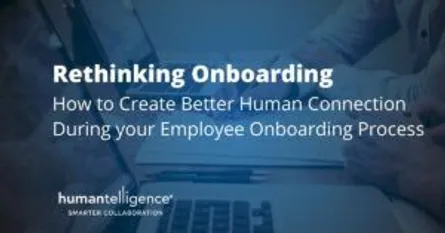
Employee onboarding

Rethinking Employee Onboarding: How to Create Better Human Connection
- 18 Dec, 2023
- Employee Onboarding , Collaboration
It's no secret...poor onboarding leads to new hires being twice as likely to seek another opportunity, with 43% of managers losing their new hire during the first month. During the current turbulent candidate market, and increased pressure on retaining talent, falling down at the last hiring hurdle isn’t an option when it comes to the employee onboarding experience. The key is creating lasting connections to help employees become passionate, productive team players. It essentially makes your onboarding process sticky. Why Improving Employee Onboarding is Important Only 17% of U.S. employees worked from home five days a week before COVID-19. At the onset of the pandemic, the percentage shot up to 44%. Very quickly, HR understood the the need to improve employee onboarding processes. We all know that onboarding and training plays a critical role in a new hire's success and happiness. And good onboarding is especially important for remote employees, since they don't have as many opportunities to integrate organically into the company culture. According to BCG, employee onboarding is among the most influential factors when it comes to employee experience. Companies that have effective onboarding processes in place achieve 2.5x more revenue growth and 1.9x the profit margin compared to organizations with poor onboarding strategies. Here, we explore some of the key building blocks -- and often forgotten components -- to improve employee onboarding for remote employees. Keeping these things in mind, you can ensure smooth onboarding even when employees are remote. As a result, you'll help increase the organization's rate of retention, engagement, and productivity of your new hires. Improving Human Connection During Onboarding Translates into Organizational Success Dale Carnegie was on to something when he said, “When dealing with people, remember you are not dealing with creatures of logic, but with creatures of emotion.” People are emotional. More than ever, they want a more personal, human work experience from their employers – and that happens when people connect and feel they belong. Organizations have to get more and more creative about how they can form multiple connections with new employees, or they risk feeling alienated and are more likely to leave. The digitization of the workplace can make people more isolated and lonely, so pre-boarding is a way to ensure inclusivity and connection-building happens before a person starts. In fact, connection is the backbone of an onboarding strategy that reduces new hire attrition, accelerates time-to-productivity, increases new hire productivity, fosters trust, drives engagement – and ultimately empowers the business to deliver better for customers. Coupled with a compelling employee experience strategy, such as assigning job-appropriate “ambassadors” and a “people-first” culture of compassion and caring, this personalized approach can continue through all an employee’s life stages Here are 10 ways to keep human connection front and center during employee onboarding and to help everyone settle into your organization with confidence — whether onsite or at home. 1. Put Video Conferencing at the Forefront No surprise, video conferencing apps gained immense popularity in spring 2020. Video conferencing platforms became a lifesaver for employers and employees, serving as a means to make face-to-face connections in the virtual work world. Instead of distributing training documentation and static, pre-recorded videos for remote employee training, employers could schedule a video onboarding training session that feels a lot like meeting in the company conference room. Plus, when onboarding, you have the chance to set expectations and make sure the employee knows that interactive, camera-on meetings will be the norm. With this approach, your employees can ask questions live and have them answered immediately among their co-workers. 2. Create Opportunities for Connection Amid COVID-19, many employees understandably experienced feelings of isolation. Create and foster pipelines for interaction, such as firing up virtual social groups, keeping those channels active, or encouraging a non-social media-centered buddy system where employees call, text or email one another. This reinforces a sense of belonging for remote employees. 3. Help Employees Manage Distractions Another facet telecommuting employees might not anticipate is the endless stream of distractions. Your virtual training tips might include strategies to help employees shut out distractions to give their work the necessary focus to get it done well and on time. At the least, encourage your employees to carve out an hour a day for remote training when they can give the material 100% of their attention. Some other tried and true tips to provide remote employees to reduce distractions:Create a schedule and stick to it Take a lunch hour and frequent breaks Get some outdoor time (if possible) Keep your workspace organized Turn off desktop and phone notifications Restrict time on your phone Establish ground rules with your family or roommates Set daily goals and objectivesWith the right tools in place, businesses can also ensure employees remain productive by using work from home monitoring software to track performance and identify workflow inefficiencies. Employee tracking solutions provide insights into how time is spent, helping managers support their teams in maintaining focus without micromanaging. For more on helping employees remove distractions while working remotely, check out these tips. 4. Invite Open Discussions on Training Questions You’re not training employees in a vacuum, and they aren’t learning in one, so keep an open line of communication to see how everything is going. Use your company intranet or another channel to solicit feedback. You can quickly and clearly clarify matters for everyone, thanks to an open forum for lively Q&A. 5. Run Online Polls for Feedback to Improve Employee Onboarding & Training When you want to gather data about remote training, run an online poll. You can provide a space for comments, questions and feedback. If you’re looking for numbers to guide your training, a poll is a quick and efficient way to get what you need. Ask questions about whether employees find the information engaging, clear, and meaningful to their daily work. This way, you're giving remote employees a way to be heard. 6. Empower Remote Employees to Become Self-Guided Learners With today’s online education and training opportunities, you can put the power of learning in your team members’ hands. Let employees know what you need from them, then allow them to explore their options. That doesn’t mean you set them loose without any guidance. Offer guideposts, such as resources your organization would use, or free access to training programs. Since workers already spend a great deal of time working remotely, it isn’t a stretch to approach learning similarly. Plus when people own when and how they learn, they tend to retain it better. For additional support, employees can also consider finding professional online tutors in the UK or the US and get personalized guidance to further enhance their learning experience. 7. Create and Use Breakout Rooms If you want to schedule a mass training session for everyone before turning matters over to department managers and their respective teams, use breakout rooms to create several smaller sessions. With the right platform, everyone can easily switch to enjoy seamless strands of training relevant to their needs. 8. Offer Strong Training Visuals as Reminders In your video meetings, provide employees with strong visuals to help them understand the material, such as spreadsheets, slideshow presentations, infographics and videos that drive home your training points. About two-thirds of people are visual learners, and studies suggest that four in ten people respond better to visuals and text compared to text alone. Other research shows using visuals can help improve retention and learning by up to 400 percent, so make sure to include compelling visuals to enhance learning. 9. Provide On-Demand Training Options Inherent in remote employment is flexibility. There are times when employees can’t join a live video meeting or audio conference call, so ensure that they can catch up when they have time with on-demand options. Provide absent team members with the recorded session and any supplemental documents, spreadsheets or information they need to stay up to speed for the times they can’t make a virtual meeting in-person. 10. Focus on People Not Process to Improve Employee Onboarding How your company communicates, enables meaningful collaboration, and supports relationship building for both onsite and remote employees usually ends up making or breaking your new hires’ remote onboarding experience. That's why it's critical to focus on people not process or paperwork during this process.. These critical elements are often overlooked during onboarding, but that's where you can employ certain technologies to help. For example, Humantelligence's Smarter Collaboration surfaces emotional intelligence insights and tips directly into the tools your employees use every single day – like Outlook email and calendar, Microsoft Teams, Gmail, Google Calendar, Slack, Zoom, Webex, and more. This simple plug-in takes the guesswork out of how to better understand and effectively communicate with others so your new employees can focus on what matters most – and that’s becoming an impactful member of the team. In addition, be sure to spend time helping your new remote hires integrate into their team. Understanding how they compare in working styles and tendencies to both those with whom they work and their managers will help your new hire understand how best to contribute to the team, smooth the transition, collaborate more effectively, and accelerate productivity. Resources to Improve Employee Onboarding We hope our remote onboarding and training ideas help you feel more confident about bringing new employees into the mix, even if they never or rarely step foot in your office. Today’s technology offers a bounty of options to welcome and engage new employees or help current employees cultivate a sense of belonging and connection with their new and existing colleagues.